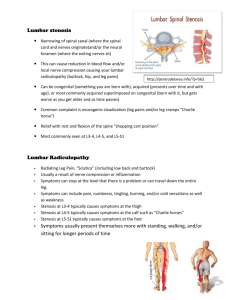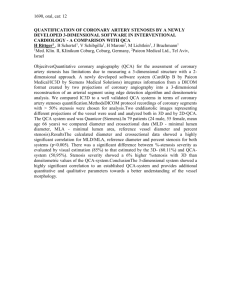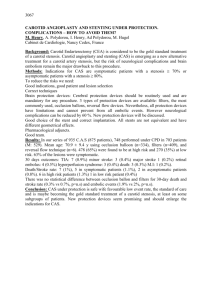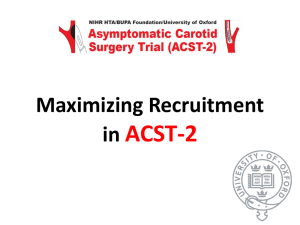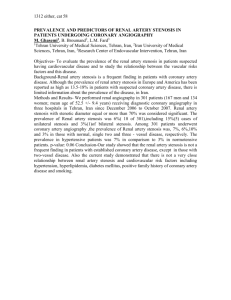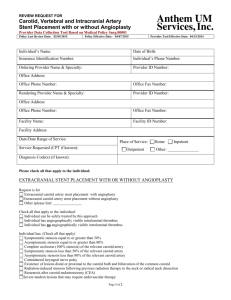A Macroscopic Two-Phase Blood Flow through a Bell Shaped
advertisement
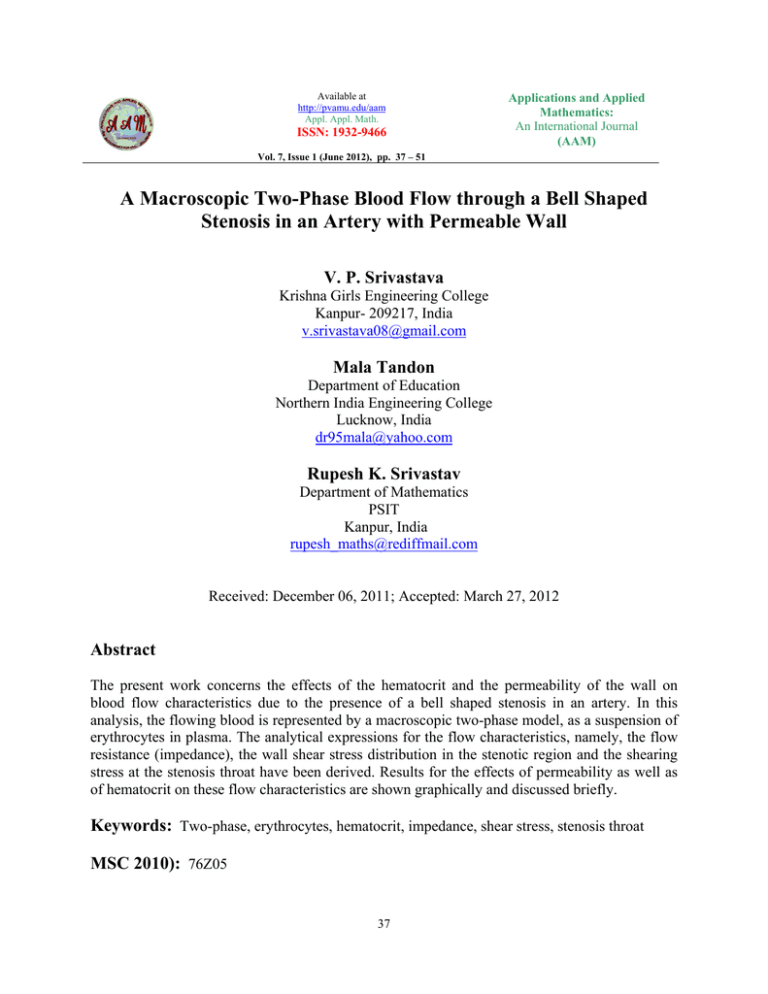
Available at http://pvamu.edu/aam Appl. Appl. Math. ISSN: 1932-9466 Applications and Applied Mathematics: An International Journal (AAM) Vol. 7, Issue 1 (June 2012), pp. 37 – 51 A Macroscopic Two-Phase Blood Flow through a Bell Shaped Stenosis in an Artery with Permeable Wall V. P. Srivastava Krishna Girls Engineering College Kanpur- 209217, India v.srivastava08@gmail.com Mala Tandon Department of Education Northern India Engineering College Lucknow, India dr95mala@yahoo.com Rupesh K. Srivastav Department of Mathematics PSIT Kanpur, India rupesh_maths@rediffmail.com Received: December 06, 2011; Accepted: March 27, 2012 Abstract The present work concerns the effects of the hematocrit and the permeability of the wall on blood flow characteristics due to the presence of a bell shaped stenosis in an artery. In this analysis, the flowing blood is represented by a macroscopic two-phase model, as a suspension of erythrocytes in plasma. The analytical expressions for the flow characteristics, namely, the flow resistance (impedance), the wall shear stress distribution in the stenotic region and the shearing stress at the stenosis throat have been derived. Results for the effects of permeability as well as of hematocrit on these flow characteristics are shown graphically and discussed briefly. Keywords: Two-phase, erythrocytes, hematocrit, impedance, shear stress, stenosis throat MSC 2010): 76Z05 37 38 V. P. Srivastava, Mala Tandon and Rupesh K. Srivastav 1. Introduction The generic medical term stenosis or arteriosclerosis, is the narrowing of anybody passage, tube or orifice, stems from the Greek words arthero (gruel or paste) and sclerosis (hardness). It is a frequently occurring cardiovascular disease (an abnormal and unnatural growth in the arterial wall thickness) develops at the various locations of the cardiovascular system under diseased conditions and occasionally results in to serious consequences (cerebral strokes, myocardial infarction, angina pectoris, cardiac arrests, etc). Although, the etiology of the initiation of stenosis is not completely understood, it is believed that the disease occurs due to the deposits of the cholesterol, fatty substances, cellular waste products, calcium and fibrin in the inner lining of an artery. It is further known that once the constriction has developed, it brings about the significant changes in the flow field. With the knowledge about cardiovascular disease, stenosis is closely associated with the flow conditions and other hemodynamic factors, a large number of researchers including Young (1968, 1979), Young and Tsai (1973), Caro et al. (1978), Shukla et al. (1980), Ahmed and Giddens (1983), Sarkar and Jayaraman (1998), Pralhad and Schultz (2004), Jung et al. (2004), Liu et al. (2004), Srivastava and coworkers (1996, 2009, 2010a,b,c), Mishra et al. (2006), Ponalagusamy (2007), Layek et al. (2009), Joshi et al. (2009), Mekheimer and El-Kot (2008), Tzirtzilakis (2008), Mandal and coworkers (2005, 2007), Politis et al. (2007, 2008), Singh et al. (2010), Medhavi (2011), and many others have addressed the stenotic development problems under various flow situations since the first investigation of Mann et al. (1938). Barring a few, most of the studies conducted in the literature considered blood as a single-phase Newtonian or non-Newtonian fluid. However, the experimental observations of Cokelet (1972) and theoretical investigation of Haynes (1960) indicate that blood cannot be treated as a singlephase homogeneous viscous fluid while flowing through narrow arteries (of diameter 1000 m ). Srivastava and Srivastava (1983) observed that the individuality of red cells (of diameter 8 m ) is significant even in such large vessels with diameter up to hundred cells diameter and concluded that blood can be suitably represented by a macroscopic two-phase model (i.e., a suspension of red cells in plasma) in small vessels (of diameter 2400 m ). Recently Srivastava (2007) has presented a brief discussion and survey on suspension modeling of blood. In addition, the endothelial walls are known to be highly permeable with ultra microscopic pores through, which filtration occurs. Cholesterol is believed to increase the permeability of the arterial wall. Such increase in permeability results from dilated, damaged or inflamed arterial walls. It is also known that stenosis may develop in series (multiple stenosis), overlapping, bell shaped, of composite nature or of irregular shape (Srivastava et al., 2010). Assuming that the flowing blood is represented by a macroscopic two-phase model (i.e., a suspension of erythrocytes in plasma), the research reported here is devoted to study the flow of blood through a bell shaped stenosis in an artery with permeable wall. The flow in the permeable boundary is described by Darcy law. The wall in the vicinity of the stenosis is usually solid when stenosis develops in living vasculature. To neglect the entrance, end and special wall effects the artery length is considered large enough as compared to its radius. AAM: Intern. J., Vol. 7, Issue 1 (June 2012) 39 2. Formulation of the Problem Consider the axisymmetric flow of blood through a bell shaped stenosis, specified at the location as shown in Figure1, in an artery with permeable wall. The geometry of the stenosis, assumed to be manifested in the arterial wall segment, is described as m 2 2 z 2 R( z ) 1 exp , 2 R0 R0 R0 (1) Figure 1. The geometry of a bell shaped stenosis with permeable wall. where R0 is the radius of the arterial segment in the non-stenotic region, R(z) is the radius of the stenosed portion located at the axial distance z from the left end of the segment, δ is the depth of stenosis at the throat and m is a parametric constant, ε the relative length of the constriction, defined as the ratio of the radius to the half length of the stenosis, i.e., R0 / L0 . The equations describing the steady flow of a two-phase macroscopic model of blood may be expressed (Srivastava and Srivastava, 1983, 1989) as u f z (1-C) f u f vf u f p (1 C ) s (C ) 2u f +CS( u p u f ), = - (1- C) r z v f v f p vf (1-C) f u f (1 C ) s (C ) ( 2 12 ) v f +CS ( v p v f ), = - (1-C) z r r r v (1 C ) v f (1 C ) f (1 C ) u f = 0, r r z u p z p up vp u p p CS ( u f u p ), = - C r z (2) (3) (4) (5) 40 V. P. Srivastava, Mala Tandon and Rupesh K. Srivastav v p z p u p vp v p p CS ( v f v p ), = - C r r Cv [C v p ] r r p [C u p ] z = 0, (6) (7) with 2 = / r 2 (1/ r ) ( / r ) 2 / z 2 as a two-dimensional Laplacian operator, r is the radial coordinate measured perpendicular to the axis of the tube. ( u f , v f ) and ( u p , v p ) are the (axial, radial) components of the fluid and particle velocities, respectively, f and p are the actual density of the material constituting the fluid (plasma) and the particle (erythrocyte) phases, respectively, (1-C ) f is the fluid phase and C p is particle phase densities, C denotes the volume fraction density of the particles, p is the pressure, s (C) ~ s is the mixture viscosity (apparent or effective viscosity) , S is the drag coefficient of interaction for the force exerted by one phase on the other, and the subscripts f and p denote the quantities associated with the plasma (fluid) and erythrocyte (particle) phases, respectively. Others limitations of the present model are the same as discussed in Srivastava and Srivastava (2009). The expressions for drag coefficient of interaction, S and the viscosity of the suspension, s for the present study are selected (Srivastava and Srivastava, 2009; Charm and Kurland, 1974) as S= 9 o 2 ao2 s (C) = 4 3[8 C 3 C 2 ] 1/2 3 C , (2 3 C ) 2 o 1 mC (8) , m = 0.070 exp [2.49C+ (1107/T) exp (-1.69C)], (9) where T is the measure in absolute scale of temperature (K) , 0 is the constant plasma viscosity and a0 is the radius of a red cell. Now following the reports of Young (1968), Srivastava and Rastogi (2009), the equations governing the laminar, steady, one-dimensional flow of blood in an artery in the case of a mild stenosis (i.e., / R0 1) are derived from equations (2)-(7) as (1-C) C dp (1 C ) s (r ) u f CS (u p u f ), dz r r r dp CS (u f u p ), dz (10) (11) AAM: Intern. J., Vol. 7, Issue 1 (June 2012) 41 The appropriate boundary conditions (Beavers and Joseph, 1967) for the problem are stated as uf r 0 at r 0, u f uB and uf r (12) k (u B u porous ) at r R( z), (13) where uporous k dp , uporous is the velocity in the permeable boundary, uB is the slip velocity, 0 dz 0 is the plasma (fluid viscosity), k is Darcy number and α (called the slip parameter) is a dimensionless quantity depending on the material parameters which characterize the structure of the permeable material within the boundary region. 3. Analysis The expressions for velocities, u f and u p obtained as the solutions of equations (10)-(11), subject to the boundary conditions (12)-(13), are obtained as uf up Ro2 dp 4 (1 C ) s dz R / R 0 2 r / R0 2 2 (1-k RC ) 0 s 2 k (1 C ) dp , (14) R / R0 dz R0 Ro2 4(1 C ) s dp 2 2 R / R0 r / R0 4 (1 C ) s dz SR02 (15) k R0 dp 2 k (1 C ) , R / R0 2 (1- C ) s dz R0 where s / 0 . The volumetric flow rate, Q is now calculated as R R 0 0 Q 2 (1- C ) r u f dr 2 C r u p dr 4 2 4 2 4( R / R0 ) k dp o R/R R/R R ( R / R ) 2 k (1 C ) 0 0 0 0 2 8(1 C ) dz R s 0 R , (16) with 8C (1 C ) s / SR , a non-dimensional suspension parameter. 2 0 From equation (16), one now obtains 42 V. P. Srivastava, Mala Tandon and Rupesh K. Srivastav 8 (1 C ) s Q dp ( z ), Ro4 dz (17) where 4( R / R0 )2 4 2 F ( z ) R / R0 R / R0 R02 ( z ) 1/ F ( z ) , k R ( R / R ) 2 0 0 k (1 C ) . The pressure drop, p ( p at z - L, p at z L) across the stenosis in the tube of length, 2L is obtained as L 8 (1 C ) s Q dp p dz , dz Ro4 -L (18) where - L0 L0 L ( z)R / R 1 dz ( z) dz ( z )R / R 1 dz . -L 0 - L0 L0 (19) 0 The first and the third integrals in the expression for obtained above are straight forward whereas the analytical evaluation of second integral is a formidable task and therefore shall be evaluated numerically. Following now the reports (Young, 1968; Srivastava and Rastogi, 2009), one derives the expressions for the impedance (flow resistance), λ , the wall shear stress distribution in the stenotic region, τ w and shearing stress at the stenosis throat, τ s in their nondimensional form as L 0 (1 C ) 1 Lo / L ( z ) dz , L - L0 (1 C ) , w 4( R / R0 ) k 3 R0 ( R / R0 ) 2 k (1 C ) R / R0 R / R0 2 R 0 s where (1 C ) 3 4a k R0 a 2 k (1 C ) a a 2 R0 , (20) (21) (22) AAM: Intern. J., Vol. 7, Issue 1 (June 2012) 1 43 4 k R 2 k (1 C ) , a 1 / R0 , / 0 , w , s w , s / 0 , R02 0 0 160 L / R04 , 0 40Q / R03 are the flow resistance and shear stress, respectively for a Newtonian fluid in a normal artery (no stenosis), and , τ w and τ s are the impedance, wall shear stress and shearing stress at stenosis throat, respectively in their dimensional form obtained from the definitions: p / Q , w ( R / 2)dp / dz , s w . R / R0 a 4. Numerical Results and Discussion To discuss the results of the study quantitatively, computer codes are developed to evaluate the analytical results obtained in equations (20)-(21) numerically in a tube of radius 0.01cm at the temperature of 370C. The values of the parameters are selected (Young, 1968; Srivastava, 1996; Beavers and Joseph, 1967) as d 0; L0 (cm) 1 . L(cm) 1, 2, 5; C 0, 0.2, 0.4, 0.6; 0.1, 0.2, 0.3, 0.4, 0.5 ; k (square root of Darcy number, k and hereafter referred as Darcy number) 0.1, 0.2, 0.3, 0.4,0.5 ; δ/R 0 0, 0.05, 0.10, 0.15, 0.20 . 1.40 1.35 .6 L=L0=1 =0.1 1/2 k =0.1 Numbers C 1.30 1.25 .4 1.20 .2 1.15 1.10 0 1.05 1.00 0.00 0.05 /R0 0.10 0.15 0.20 Fig. 2 Impedance, versus /R0 for different C. For any given set of other parameters, the impedance (resistance to flow), λ increases with hematocrit, C as well as with the stenosis height, / R0 (Figure 2). The flow characteristic, λ increases with increasing Darcy number, k for any given set of other parameters (Figure 3). One observes that the blood flow characteristic, λ increases with the slip parameter, α for other given parameters (Figure 4). The impedance, λ decreases with the increasing value of the 44 V. P. Srivastava, Mala Tandon and Rupesh K. Srivastav parameter, L (tube length/2) which in turn implies that λ increases with stenosis length, L0 (Figure 5). The resistance to flow, λ steeply increases with the hematocrit, C for any given value of α, k and / R0 (Figure 6). For other given parameters, that the blood flow characteristic, λ decreases from its maximal magnitude at k 0 to its asymptotic value at k 0.15 (Figure 7). One notices that flow resistance, λ increases with the slip parameter, α from its minimal value at α 0.1 and achieves an asymptotic magnitude at about α 0.5 (Figure 8). 1.28 .5 L=L 0=1 C=0.4 =0.1 1/2 Numbers k 1.26 1.24 .2 .3 1.22 .4 .1 1.20 1.18 1.16 1.14 1.12 0.00 0.05 0.10 0.15 /R 0 0.20 1/2 Fig. 3 Impedance, versus /R 0 for different k . 1.28 .5 L=L 0 =1 C=0.4 1/2 k =0.1 Num bers 1.26 1.24 .2 .4 1.22 .1 .3 1.20 1.18 1.16 1.14 1.12 0.00 0.05 0.10 /R 0.15 0 Fig. 4 Im pedance, versus /R 0 for different . 0.20 AAM: Intern. J., Vol. 7, Issue 1 (June 2012) 45 The wall shear stress in the stenotic region, τ w increases rapidly in the upstream of the stenosis throat from its approached value at z / L0 -1 and achieves its maximal magnitude at stenosis throat (i.e., at z / L0 0 ), it then decreases rapidly in the downstream of the throat to its approached value at the end point of the constriction profile (at z / L0 1 ). The blood flow characteristic, τ w increases with the hematocrit, C and the stenosis height, / R0 at any axial location in the stenotic region (Figure 9). At any axial location, the wall shear stress τ w increases k (Figure 10) and also with the slip parameter, α (Figure 11). with the Darcy number, 1.23 1.20 1 =0.1 1/2 k =0.1 Numbers L 2 1.17 1.14 5 C = .4 1.11 1 1.08 1.05 1.02 2 5 C=0 0.00 0.05 0.10 /R0 0.15 0.20 Fig. 5 Impedance, versus /R0 for different L. 1.40 1.35 L=L 0 =1 =0.1 1/2 k =0.1 Numbers /R 0 1.30 1.25 .20 .15 1.20 .10 .05 1.15 0 1.10 1.05 1.00 0.0 0.1 0.2 0.3 C 0.4 0.5 Fig. 6 Impedance, versus C for different /R 0 . 0.6 46 V. P. Srivastava, Mala Tandon and Rupesh K. Srivastav 1.7 1.6 1.5 L=Lo=1 C=.4 =.1 Numbers /Ro 1.4 .20 1.3 .15 .10 1.2 .05 0 1.1 0.0 0.1 0.2 1/2 k 0.3 0.4 1/2 Fig.7 Impedance, versus Darcy number, k different stenosis height, /Ro. 0.5 for .20 1.32 L=Lo=1 C=0.4 1/2 k =0.1 Numbers /Ro 1.28 .15 1.24 .10 1.20 .05 1.16 0 1.12 0.1 0.2 0.3 0.4 Fig.8 Impedance, versus slip parameter, for different stenosis height, /Ro. 0.5 AAM: Intern. J., Vol. 7, Issue 1 (June 2012) 47 1.25 L=Lo=1 1/2 k =0.1 (.2,.4) = 0.1 1.20 Numbers (/Ro,C) (.1,.4) 1.15 w (0,.4) 1.10 1.05 (.2,0) (.1,0) (0,0) 1.00 0.95 -1.0 -0.5 0.0 z/L 0.5 1.0 o Fig. 9 Wall Shear stress distribution, w in stenotic region for different /Ro and C. 1.32 1.28 L=Lo=1 C=0.4 /Ro=.15 = 0.1 1/2 Numbers k .5 .4 .3 .2 1.24 w 1.20 .1 1.16 1.12 -1.0 -0.5 0.5 1.0 z/Lo Fig.10 Wall shear stress distribution, w in stenotic region 1/2 for different k . 0.0 48 V. P. Srivastava, Mala Tandon and Rupesh K. Srivastav 1.32 L=Lo=1 C=0.4 /Ro=.15 1.29 .5 .3 1/2 .4 k = 0.1 Numbers 1.26 .2 1.23 w 1.20 .1 1.17 1.14 1.11 -1.0 -0.5 0.0 0.5 1.0 z/Lo Fig.11 Wall Shear stress distribution, w in stenotic region for different . 1.40 1.35 1.30 .6 L=L0=1 =0.1 1/2 k =0.1 Numbers C 1.25 s .4 .2 1.20 1.15 1.10 1.05 0 1.00 0.00 0.05 0.10 0.15 Fig. 12 Shear stress, s versus /R0 for different C. 0.20 AAM: Intern. J., Vol. 7, Issue 1 (June 2012) 49 1.32 .5 L=L0=1 C=0.4 =0.1 1/2 Numbers k 1.28 .3 .2 s .4 1.24 1.20 .1 1.16 1.12 0.00 0.05 0.10 /R 0 0.15 0.20 1/2 Fig. 13 Shear stress, s versus /R0 for different k . 1.32 1.29 .5 .3 L=L0=1 C=0.4 1/2 k =0.1 Numbers .2 .4 1.26 s 1.23 1.20 .1 1.17 1.14 0.00 0.05 0.10 /R0 0.15 0.20 Fig. 14 Shear stress, s versus /R0 for different . The shear stress at stenosis throat τ s increases with the hematocrit, C as well as with the stenosis height, / R0 (Figure 12). τ s also increases with Darcy number, k (Figure 13) and with the slip parameter, α (Figure 14). The blood flow characteristic τ s possesses characteristic similar to that of the flow resistance, λ with respect to any parameter (Figures 2 and 13). 50 V. P. Srivastava, Mala Tandon and Rupesh K. Srivastav 5. Conclusions To discuss the effects of the wall permeability and the hematocrit, the flow through a bell shaped stenosis in an artery with permeable wall; a macroscopic two-phase blood model has been used. The flow resistance increases with the hematocrit, stenosis size (height and length both), Darcy number and as well as with the slip parameter. The wall shear stress at any axial location in the stenotic region possesses variations similar to that of the impedance with respect to any parameter. The shear stress at stenosis throat possesses the characteristic similar to that of the impedance. REFERENCES Ahmed, A. S. and Giddens, D. P. (1983). Velocity measurements in steady flow through axisymmetric stenosis at moderate Reynolds number. Journal of Biomechanics, 16, pp. 505516. Beavers, G.S. and Joseph, D. D. (1967). Boundary conditions at a naturally permeable wall. J. Fluid Mech. 30(1), pp. 197-207. Caro, C. G. Pedley, T. J., Schroter, R.C. and Seed, W. A. (1978). The Mechanics of the Circulation. Oxford Medical, N. Y. Charm, S. E. and Kurland, G. S. (1974). Blood Flow and Microcirculation. John Wiley, N. Y. Cokelet, G.R. (1972). The Rheology of Human Blood: In Biomechanics, Prentice-Hall, Englewood Cliffs, N.J. Haynes, R.H. (1960). Physical basis on dependence of blood viscosity on tube radius. Am. J. Physiol. 198, 1193-1205, 1960. Joshi, P., Pathak, A. and Joshi, B.K. (2009). Two layered model of blood flow through composite stenosed artery. Applications and Applied Mathematics, 4(2), pp. 343-354. Jung. H. Choi, J.W. and Park, C.G. (2004). Asymmetric flows of non-Newtonian fluids in symmetric stenosed artery. Korea-Aust. Rheol. Journal, 16, 101-108. Layek, G.C., Mukhopadhyay, S. and Gorla, R.S.R. (2009). Unsteady viscous flow with variable viscosity in a vascular tube with an overlapping constriction. Int. J. Engg. Sci. 47, pp. 649659. Layek, G.C., Mukhopadhyay, S. and Samad, Sk. A. (2005). Oscillatory flow in a tube with multiple constrictions, Int. J. Fluid Mech. Res. 32, pp. 402-419. Liu, G.T., Wang, X.J., Ai, B.Q. and Liu, L.G. (2004). Numerical study of pulsating flow through a tapered artery with stenosis. Chin. Journal Phys., 42, pp. 401-409. Mandal, P.K. (2005). An unsteady analysis of non-Newtonian blood flow through tapered arteries with a stenosis. Int. J. of Nonlinear Mechanics. 40, pp. 51–164. Mandal, P.K., Chakravarty, S. and Mandal, A. (2007). Numerical study on the unsteady flow of non-Newtonian fluid through differently shaped arterial stenosis. Int. J. Comput. Math. 84, pp. 1059-1077. Mann, F. C., Herrick, J. F., Essex, H. E. and Blades, E. J. (1938). Effects on blood flow of decreasing the lumen of blood vessels. Surgery 4, pp. 249-252. Medhavi, A. (2011). On macroscopic two-phase arterial blood flow through an overlapping stenosis. E-Journal of Science and Technology 6, pp. 19-31. AAM: Intern. J., Vol. 7, Issue 1 (June 2012) 51 Mekheimer, Kh.S. and Kot, A. M. E. (2008). Magnetic field and hall currents influences on blood flow through a stenotic arteries. Applied Mathematics and Mechanics, 29, pp. 1-12. Misra, J.C. and Shit, G.C. (2006). Blood flow through arteries in a pathological state: A theoretical study. Int. J. Engg. Sci. 44, pp. 662-671. Politis, A. K., Stavropoulos, G. P., Christolis, M. N., Panagopoulos, F. G., Vlachos, N. S., and Markatos, N. C. (2007). Numerical modeling of simulated blood flow in idealized composite arterial coronary grafts: Steady state simulations. J. Biomech., 40(5), pp. 1125–1136. Politis, A. K., Stavropoulos, G. P., Christolis, M. N., Panagopoulos, F. G., Vlachos, N. S., and Markatos, N. C. (2007). Numerical modeling of simulated blood flow in idealized composite arterial coronary grafts: Transient flow. J. Biomechanics. 41(1), pp. 25-39. Ponalagusamy, R. (2007). Blood flow through an artery with mild stenosis: A two-layered model Model, different shapes of stenosis and slip velocity at the wall. J. Appl. Sci. 7(7), pp.10711077. Pralhad, R.N. and Schultz, D.H. (2004). Modeling of arterial stenosis and its applications to blood diseases. Math. Biosci., 190, pp. 203-220. Sarkar, A. and Jayaraman, G. (1998). Corretion to flow rate-pressure drop in coronary angioplasty; steady streaming effect. Journal of Biomechanics, 31, pp. 781-791. Shukla, J. B., Parihar, R. S. and Gupta, S. P. (1980). Effects of peripheral layer viscosity on blood flow thorough the arterywith mild stenosis. Bull. Math. Biol. 42, pp. 797-805. Singh, B., Joshi, P. and Joshi, B.K. (2010). Blood flow through an artery having radially nonsummetric mild stenosis. Appl. Math. Sci. 4(22), pp. 1065-1072. Srivastava, L. M. and Srivastava, V. P. (1989). Peristaltic transport of a particle-fluid suspension. Trans. ASME J. Biomech. Engng. 111, pp. 157-165. Srivastava, L.M. and Srivastava, V.P. (1983). On two-phase model of pulsatile blood flow with entrance effects. Biorheol. 20, pp. 761-777. Srivastava, V. P. and Rastogi, R.(2009). Effects of hematocrit on impedance and shear stress during stenosed artery catheterization. Applications and Applied Mathematics, 4, pp. 98113. Srivastava, V. P., Rastogi, R. and Vishnoi, R. (2010). A two-layered suspension blood flow through an overlapping stenosis. Computers and Mathematics with Applications 60, pp. 432-441. Srivastava, V.P. and Srivastava, Rashmi (2009). Particulate suspension blood flow through a narrow catheterized artery. Comput. Math. Applic.58, pp. 227-234. Srivastava, V.P. (1996). Two-phase model of blood flow through stenosed tubes in the presence of a peripheral layer: J. Biomech. 29, pp. 1377-1382. Tzirtzilakis, E.E.(2008). Biomagnetic fluid flow in a channel with stenosis, Physica D. 237, pp. 66-81, 2008. Young, D. F. and Tsai F. Y. (1973). Flow characteristics in model of arterial stenosis-steady flow. Journal of Biomechanics, 6, pp. 395-410. Young, D. F. (1968). Effects of a time-dependent stenosis of flow through a tube. Journal of Eng. Ind., 90, pp. 248-254. Young, D. F. (1979). Fluid mechanics of arterial stenosis. J. Biomech. Eng. ASME. 101, pp. 157-175, 1979.

